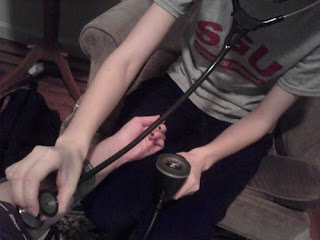
photo credit-Jun's World
Creative Commons license
Sleep.
One of the most common, natural things there is. Most of us never think about it much at all, until we (or someone close to us) has problems related to it. There are a multitude of disorders that can affect our sleep. Insomnia, sleep apnea (central or obstructive), narcolepsy, sleep paralysis, sleep walking, night terrors, etc. You get the idea. Sleep disorders of one sort or the other seem to be a lot more common in those on the autism spectrum.
Buddy Boy has never seemed to require (or want) the same amount of sleep that most kids his age get. We've tried regular routines, music, melatonin, night lights, and various other meds to try to get him to sleep thru the night. We've gotten to the point where he'll go to bed at a predictable time (8:30-9:00 pm-not bad for an almost 10 year old), and usually sleeps until 6:00 am, though sometimes he's up at 2:00 or 4:00, and stays up for the day after that. We're fairly accustomed to his routine. That's not the problem.
Sweet Pea, his 7 1/2 year old sister, has been having sleep related problems since August. At first it was her getting up every night screaming. When we'd come into the room, she'd complain that her stomach was hurting. Mostly it was an epigastric centered pain, and only occurred at night. When she woke in the morning, she still complained of stomach pain, and her diet (which Liz had pretty full of good things-protein, vegetables, fruit), devolved to milk, cheerios, and cheese. Everything else hurt to eat (according to her).
At first I felt it was most likely related to anxiety regarding school starting up (Sweet Pea is a fairly high anxiety kind of kid) and hoped that by not paying too much attention to it it would go away. Well, Sweet Pea got into the swing of school, liked school, and it didn't go away. I took her to a pediatric GI doctor near the end of September, after starting her on some Prilosec (Sweet Pea had reflux pretty bad as an infant, and I thought it reasonable that perhaps it had recurred). The GI doctor agreed, and she is now on daily Prilosec. The stomach aches have "mostly" gone away (though not completely-when she was an infant putting her on Prilosec changed her in 48 hours from a miserable baby who cried every night for three months straight to a happy, smiling kid). Her diet, now that she's on the Prilosec, has once again normalized.
Sweet Pea continued to wake up most nights, sometimes screaming, sometimes coming in to wake us up. Most nights it's sometime between 1:00 and 3:00 am. Although it's somewhat disruptive to me, it's majorly disruptive to Liz, who often can't get back to sleep (internship was good training for me). For the last several weeks Liz has been sleeping downstairs in the family room, so as to try to get some sleep. She also has not been very happy. :(
Sweet Pea's pediatrician has prescribed a mild anti-anxiety agent, which has helped some, but not completely. Instead of 5-6 nights out of 7, we're down to 2-3 nights out of 7. Not even paying her 25 cents to not wake us has helped (Sweet Pea will make lots of money when she grows up-she is very focused on making money-to the point that I constantly remind her of all the other really important things out there that are more important).
We, being experts in sleep as much as anyone out there, have tried as many different things as we could think of. I'm not really looking for any new ideas, just venting a bit, I guess.
And dreaming of the day when both kids will sleep through the night.
































